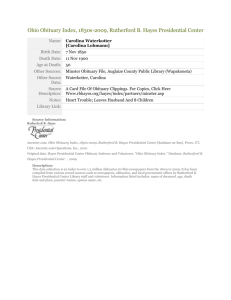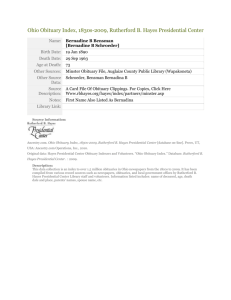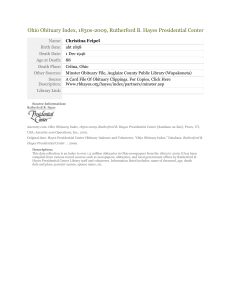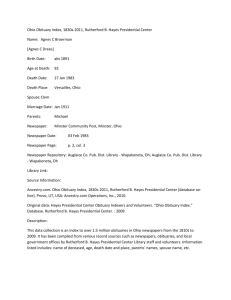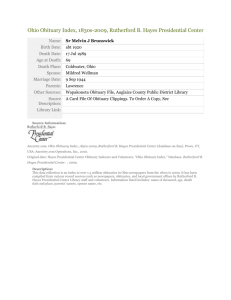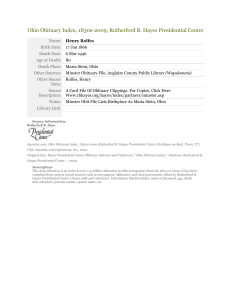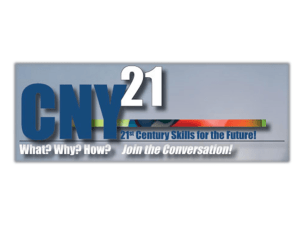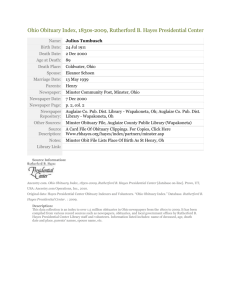Untarnishing the Gilded Age: - The Rutherford B. Hayes Presidential
advertisement
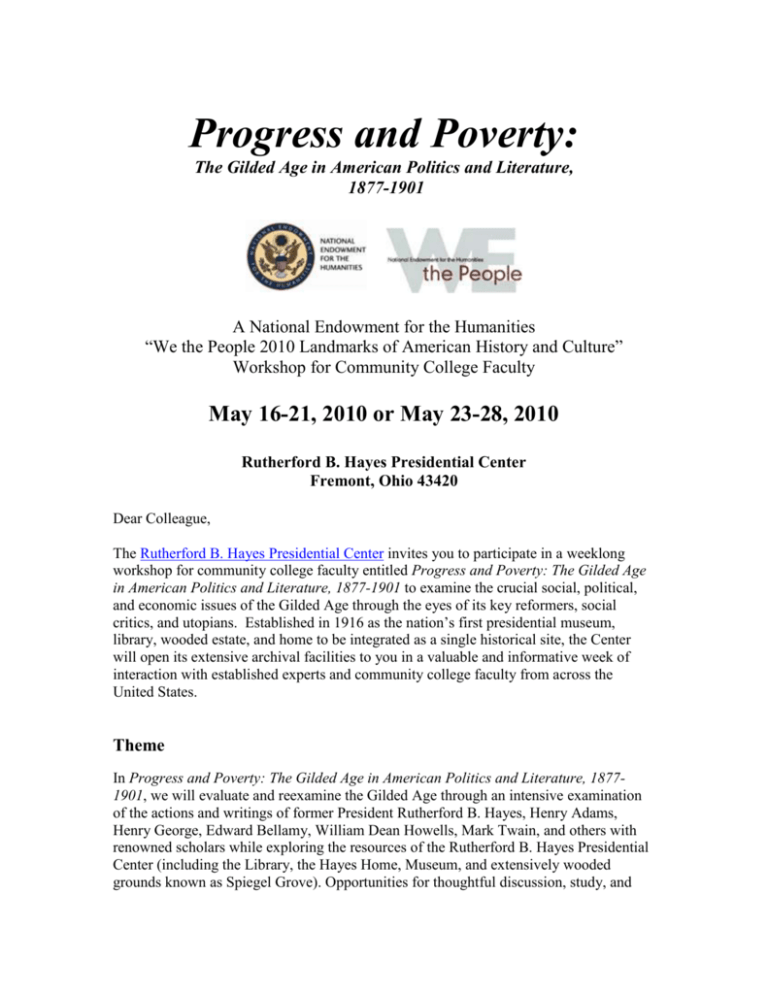
Progress and Poverty: The Gilded Age in American Politics and Literature, 1877-1901 A National Endowment for the Humanities “We the People 2010 Landmarks of American History and Culture” Workshop for Community College Faculty May 16-21, 2010 or May 23-28, 2010 Rutherford B. Hayes Presidential Center Fremont, Ohio 43420 Dear Colleague, The Rutherford B. Hayes Presidential Center invites you to participate in a weeklong workshop for community college faculty entitled Progress and Poverty: The Gilded Age in American Politics and Literature, 1877-1901 to examine the crucial social, political, and economic issues of the Gilded Age through the eyes of its key reformers, social critics, and utopians. Established in 1916 as the nation’s first presidential museum, library, wooded estate, and home to be integrated as a single historical site, the Center will open its extensive archival facilities to you in a valuable and informative week of interaction with established experts and community college faculty from across the United States. Theme In Progress and Poverty: The Gilded Age in American Politics and Literature, 18771901, we will evaluate and reexamine the Gilded Age through an intensive examination of the actions and writings of former President Rutherford B. Hayes, Henry Adams, Henry George, Edward Bellamy, William Dean Howells, Mark Twain, and others with renowned scholars while exploring the resources of the Rutherford B. Hayes Presidential Center (including the Library, the Hayes Home, Museum, and extensively wooded grounds known as Spiegel Grove). Opportunities for thoughtful discussion, study, and research during the workshop will help you to inspire your students to think critically about Gilded Age issues and how they relate to the modern era. The Gilded Age represents a period of tremendous social, political, and economic change in the United States. This period, which was bisected by the Presidency of Rutherford B. Hayes (1877-1881), witnessed a broad range of historical events including the formal end of Reconstruction, the Railroad Strike of 1877, Chinese Exclusion Act of 1882, Pendleton Act (1883), Haymarket Riot (1886), and Homestead Strike (1892). It also witnessed continuing questions about the conditions facing Native Americans in the West and the rise of modern metropolises dominated by skyscrapers and marred by squalor. These aspects reflect some of the anxieties of the time and perhaps all time —fear of immigration, distrust of politicians, concerns about corporate responsibility. President Hayes, to a remarkable extent, stands as a barometer of the era. As either an active participant or diarist, Hayes interacted with many of the Gilded Age’s key forces and figures. This makes the Hayes Presidential Center an ideal place to study and reexamine the Gilded Age using an expansive array of political cartoons and periodicals and newspapers from the era as well as President Hayes’ personal (and sometimes annotated) copies of the key printed works of Bellamy, Howells, Twain. The Center’s collection also includes copies of Hayes’ diaries and letters and manuscripts from other political, social, and literary figures of the era. Content, Readings, and Guest Scholars Progress and Poverty will examine the period from 1877 through 1901 through an analysis of the age through its contemporary commentators and critics. As part of the examination of each day’s theme, we will explore different aspects of the Hayes Presidential Center as a national landmark. Sunday: Welcoming Reception After arriving at your accommodations, you will be transported to the Hayes Presidential Center for a welcoming reception where we will meet each other and the staff. The staff will open the workshop with a brief tour of the Center and an outline of the week’s activities. Monday: Introduction to the Gilded Age On the first day, Dr. Rebecca Edwards, author of New Spirits of the Gilded Age, 1865-1905 and Angels in Machinery: Gender in American Party Politics from the Civil War to the Progressive Era, will provide an overview of the Gilded Age, and Dr. Brooks D. Simpson, author of The Political Education of Henry Adams and The Reconstruction Presidents and Reconstruction, will examine the role of Henry Adams and other contemporary critics in shaping—and a times misshaping—perceptions of the Gilded Age. We will also tour the Hayes Museum, Library, and Archives. Tuesday: Politics and Social Justice Professor Edwards will examine electoral politics and economic developments in the post-Civil War era, focusing on the South and the West. In the course of her presentation, she will include an analysis of Lucy Webb Hayes’ association with the WCTU. Professor Simpson’s presentation will focus on the role of Henry George and his key work, Progress and Poverty, as well as Edward Bellamy’s Looking Backward 2000-1887 in shaping the movement toward political, social, and economic reform. Executive Director Thomas Culbertson will offer a focused presentation on Hayes’ attitudes toward the rights of labor as well as the paradox between his hopes for the post-war South and the reality which ensued. Drs. Edwards and Simpson will engage in small group discussions and Library Director Rebecca Hill will lead you in utilizing the research resources of the Library. In the evening, as a testament to Hayes’ concern with species propagation, you will go on a walking tour of Spiegel Grove, Hayes’ extensively wooded estate. Wednesday: Labor Unrest and Utopian Reactions Dr. Timothy Messer-Kruse will lead a discussion of capital and labor in the Gilded Age. In “All Things New: Individualism and Community,” Dr. Robert Fogarty will examine utopian reactions to the conflicts of the Gilded Age. Drs. Messer-Kruse and Fogarty will engage in a question and answer session. Thomas Culbertson will lead tours of the Hayes Home. Nan Card, Curator of Manuscripts, will lead you in an examination of manuscripts, including correspondence copies and manuscripts of William Dean Howells. Thursday: Realism and Utopianism in American Literature: Howells and Twain Dr. Steven Culbertson will offer a brief analysis of Hayes’ interactions with William Dean Howells and Mark Twain and his response as an informed reader of Howells’ A Hazard of New Fortunes and Annie Kilburn Twain’s A Connecticut Yankee at King Arthur’s Court and The Prince and the Pauper. In his presentation entitled “The All-Seeing Eye of W.D. Howells: 1885-1895,” Dr. Sanford Marovitz will introduce you to William Dean Howells’ social fiction. Concentrating on A Hazard of New Fortunes, Annie Kilburn, and A Traveler from Alturia, Dr. Marovitz will examine Howells’ role as both a realist and a utopian. Dr. Michael J. Kiskis will begin a two-part discussion of realism and utopianism in American Literature and their impact on Gilded Age culture. Using The Prince and the Pauper and A Connecticut Yankee in King Arthur’s Court as his reference points, Dr. Kiskis will “explore the intersection of Mark Twain’s life with the larger questions of progress and poverty in mid-nineteenth century America.” While he will examine the social criticism in these two major novels, he will also “suggest that there is much to be gained from placing Mark Twain’s work within a domestic context—personal, literary, and social—as part of an exploration of Mark Twain’s writings that spread through 1877-1901. The afternoon will feature a series of rotating small group sessions. You will meet with Drs. Marovitz and Kiskis. Gil Gonzalez will present a workshop on images from the Center’s collection (including photographs of key figures (Howells, Twain, Hayes, etc.) and events (political rallies, strikes, etc.). He will also address the challenges and possibilities of using them in presentations. You will also be able to work with the Manuscript Collection and research in the Library. Friday: Case Study American Realism and Utopianism Drs. Marovitz and Kiskis will continue their investigation of late nineteenthcentury realism and utopianism in the works of W.D. Howells and Mark Twain. In the afternoon, you will present your initial findings to the group. Research and Teaching Projects Hayes Presidential staff members have designed the workshops to assist you in your teaching and research in the Gilded Age time period. You have the opportunity to choose from two tracks: developing materials to support your Gilded Age work in the classroom or conducting research to support a paper for presentation at a conference or for publication. You will be able to use original manuscripts, books, photographs, periodicals and artifacts discussed in the Landmark section of this letter to develop classroom materials or support a paper. In conjunction with these resources we will be able to tap into the expertise of the Center’s staff, including Executive Director Thomas Culbertson, Curator of Manuscripts Nan Card, Head of Photographic Resources Gil Gonzalez, and Head Librarian Rebecca Hill. Workshop Landmarks The Rutherford B. Hayes Presidential Library The Rutherford B. Hayes Presidential Library opened as the first presidential library in 1916. It incorporates Hayes’ personal library, which exceeds 12,000 volumes--a testament to Hayes’ personal literacy and level of intellectual curiosity as well as a clear response to those who would dismiss his period as one of simple graft and unquestioned corrupt business practices. These volumes, which are sometimes annotated in his own hand, bear witness to his having read and reacted to the reform writers of his age including Henry George (Progress and Poverty) and Edward Bellamy (Looking Backward, 2000-1887). In addition to books addressing his time in office (1877-1881), the Library’s 75,000 books cover the Gilded Age, genealogy, and local history. The Manuscript Division contains over 4,500 linear feet of documentary material in six major areas: Rutherford B. Hayes and the Hayes family, the Gilded Age, the Charles E. Frohman Collection (Great Lakes and Erie Islands), Local History of Northwest Ohio, Local Government, and Special Collections. The Library also contains a rich array of political and editorial cartoons (separately and in bound magazines and journals). The Museum The Museum, built in 1916 and subsequently expanded in 1922 and 1968, houses 13,000 artifacts, of which 1,785 are on permanent display. Exhibits combine historical artifacts and manuscripts to explain Rutherford B. Hayes’ Civil War service as well as his record as Congressman, Governor, and ultimately, President of the United States. The Hayes Home Architecture played a key role in the Victorian Age. As Geoffrey Blodgett’s “The Architectural Psychology of the Gilded Age” has noted, “Perhaps no other generation of Americans left an architectural deposit more disconcerting to the tastes of its successors…...Still there is no denying that post-Civil War buildings bear a distinct stamp peculiar to their time. They are heavier, more stolid and elaborate, both in the massing of forms and the texture of surfaces. To our eye there seems to be an overstuffed quality to many of them.” The Hayes home and comparable structures located near Spiegel Grove offer great insights into this Victorian architecture. Spiegel Grove Hayes’ twenty-five acre wooded estate known as Spiegel Grove highlights the President’s interest in conservation and propagating new varieties of plants and trees. In this effort, he was both of his time and ahead of his time. As early as 1882, President Chester A. Arthur, had sounded an alarm concerning the Nation’s woodlands: “The condition of the forests of the country and the wasteful manner in which their destruction is taking place give cause for serious apprehension. Their action in protecting the earth’s surface, in modifying the extremes of climate, and in regulating and sustaining the flow of springs and streams is now well understood….” Hayes’ personal diary, which is available both in print form and on-line via the Presidential Center’s website, provides extensive documentation of his interest in preserving forestland. Logistics Who The program is open to full- and part-time community college faculty in the United States in any field, but will be most valuable to instructors in the humanities and social sciences. When Each workshop begins Sunday evening with an informational reception and ends Friday afternoon. There are two workshops to choose from: May 16-21 or May 23-28, 2010. Please indicate your order of preference regarding the week you would like to attend. Participants should arrive on Sunday May 16 or Sunday May 23 in time for the 7:15 p.m. opening reception that evening. The staff of the Hayes Presidential Center will welcome participants, facilitate introductions and share essential information about the workshops. Where The workshop sessions will be held, for the most part, at the Rutherford B. Hayes Presidential Center in Fremont, Ohio. Fremont is located 40 miles east of Toledo and 90 miles west of Cleveland just off the Ohio Turnpike, I 90. The preferred airport is Cleveland Hopkins, which is about 90 minutes from Fremont. Once participants are selected, the Hayes Center will make limited airport shuttle arrangements to transport them to the Center. However, participants may wish to have a car, especially if they want to explore the area before or after the workshop. Accommodations and Meals Our Lady of the Pines While in Fremont, we encourage you to stay at Our Lady of the Pines, a beautiful retreat center that has been reserved by the Hayes Presidential Center. The Pines is located about one-half mile from the Hayes Presidential Center. It is an easy walk, but a shuttle will be provided daily to and from the Hayes Presidential Center. The dorm-like rooms are private with private baths (12 ensuite), but all rooms have individual bathrooms. See top page for link to photos of the interior. Breakfast and dinner are included in a cafeteria-style setting. The Pines is designed to promote a quiet, collegial atmosphere with several common areas for gathering in small groups. It recently underwent extensive renovations throughout the facility and added internet access in a common area and hopes to have wireless installed throughout before the conference. The cost for the week, including breakfast and dinner, is $325. Because of the retreat atmosphere there are no phones or televisions in the rooms at Our Lady of the Pines, but there are phones and internet connections in common areas. You may also use computers at the Hayes Presidential Center Library to access email during the week. The Comfort Inn Fremont has a limited number of available hotels as well. The Comfort Inn is the closest option. It offers a continental breakfast and nearby restaurants serve dinner, but it is not in walking distance to the Center so a car will be needed. There will be no shuttle service to the Center. The Comfort Inn has free wireless internet access. Lunches The Hayes Presidential Center will supply your lunch each day. Please specify any special dietary needs, such as vegetarian or food allergies. Traveling with Family Members Our Lady of the Pines will not be able to accommodate families. Participants who wish to travel with family members should plan to stay in a hotel such as the Comfort Inn and to drive or rent a car. NEH does not allow family as auditors in the sessions, but family may attend social events. Stipend You will receive a stipend of $1200 to help cover the cost of food and lodging and defray travel costs. The stipend will be distributed at the close of the workshop. Attractions in Northwest Ohio Northwest Ohio offers a variety of recreational and educational attractions. Fremont is about twenty miles from Lake Erie. Cedar Point Amusement Park in nearby Sandusky, Ohio is surrounded by three indoor water parks. The Toledo area features Fort Meigs, a historical site from the War of 1812, Side Cut Metropark (part of the former Miami and Erie Canal), the Toledo Zoo, and the world-renowned Toledo Museum of Art. Again, participants who wish to visit these sites will need to do so before or after the workshop. Application You will need to complete the application, following the instructions outlined in the attached NEH document. Please collate and staple your application in the following order: cover sheet, essay, and resume. The four components of the application are 1. 2. 3. 4. The application cover sheet, which should be completed online. The application cover sheet is available at http://www.neh.gov/online/education/participants. (Click on “Landmarks” grant. Submit one copy electronically to the NEH.) Three hard copies will also be submitted by mail to the Project Director at the address below. A one page double-spaced typed essay. The essay, which is the most important part of the application, should include information about your professional background and interest in the subject of the workshop; your special perspectives, skills, or experiences that would contribute to the workshop and how the experience would enhance your teaching or research. Please submit three hard copies to the Project Director. Three hard copies of your resume submitted to the Project Director. A letter of recommendation from your dean or department head. This should be mailed or given to the applicant with his/her signature across the flap. Only one copy is needed. Your completed application must be postmarked no later than March 2, 2010 and addressed as follows: Steven L. Culbertson Project Director The Rutherford B. Hayes Presidential Center Spiegel Grove Fremont, Ohio 43420 Successful candidates will be notified by April 1, 2010. If accepted, applicants must confirm their participation by April 10. Once participation is confirmed, you will receive a packet of information that includes a detailed agenda, workshop readings, and travel and housing information. Should you have any further questions about the workshops, please do not hesitate to email, call, or write me. I look forward to hearing from you. Sincerely, Steven L. Culbertson Project Director steven_culbertson@owens.edu (419) 332-2081
